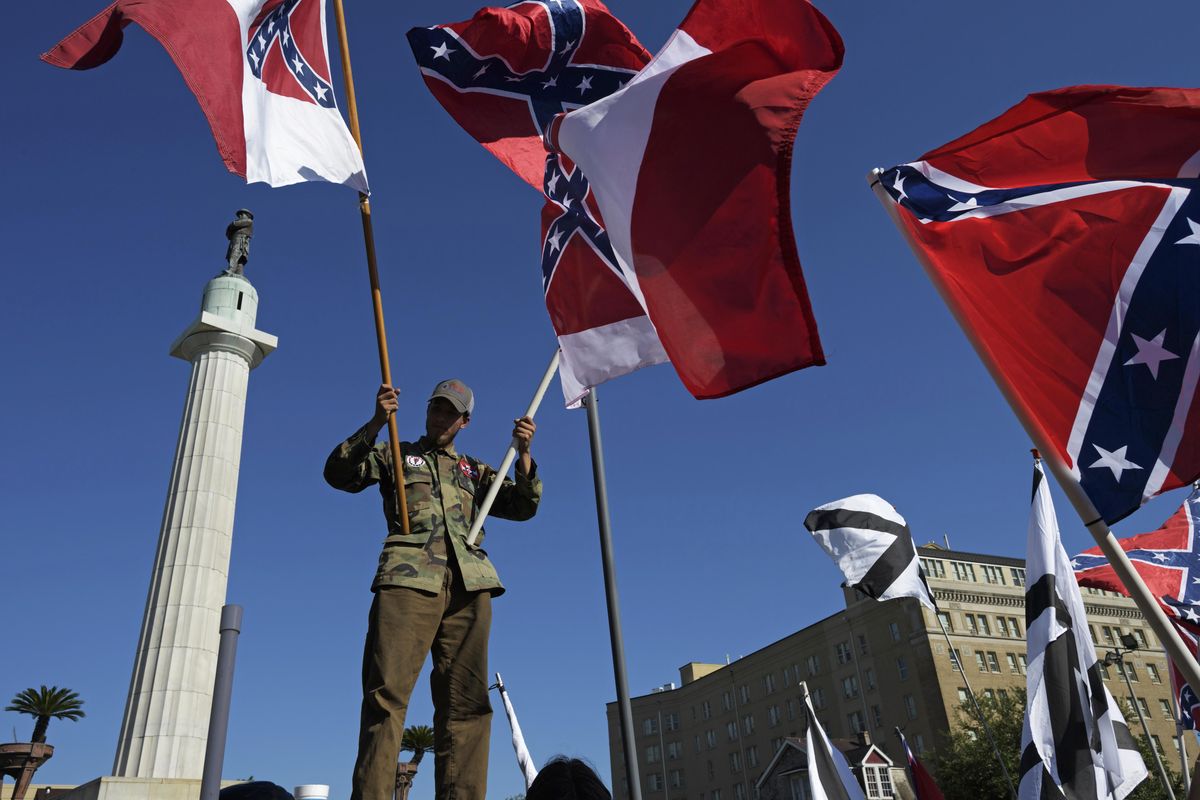Tensions rise as New Orleans prepares to topple Confederate monuments

NEW ORLEANS – At Lee Circle, an intersection less than a mile from one of the Mississippi River’s snaking bends through this city, local legend has it that the statue of Confederate Gen. Robert E. Lee stands, arms folded, facing north so as to keep an eye on his adversaries.
On Sunday, some of those adversaries marched in a second-line parade to the traffic circle where Lee’s statue stands – centurion-like, stationed above the treeline atop a white stone pedestal – to protest the monument’s place in the circle and to bury Lee’s place in history, which some revere and others revile. They were met by Confederate-flag wavers keeping vigil there, some wearing riot gear or motorcycle helmets.
The tense meeting came amid a debate about the future of the 130-year-old monument to the Confederate army leader. In December 2015, after days of public discussion, the New Orleans City Council voted to remove the Lee monument and three others honoring the Confederacy from prominent public spaces around town. Proponents of the memorials mounted a legal fight to save them, but lost.
Mayor Mitch Landrieu, a Democrat, has vowed to remove Lee’s statue and two other prominent memorials – one to Gen. P.G.T. Beauregard in City Park and another of Confederate President Jefferson Davis in a greenway in the Mid-City neighborhood – in short order, as soon as this week, by some reports. But city officials have refused to provide precise dates, because of threats made against contractors involved in removing the statues. When the Battle of Liberty Place monument, a memorial honoring those who died in an attempt to overthrow the city government after the Civil War, came down two weeks ago, contractors did the work in the middle of the night wearing kevlar and face masks.
“The time surely comes when (justice) must and will be heard,” Landrieu told the council in 2015, explaining why he and others believed the statues must go. “Members of the council, that day is today. The Confederacy, you see, was on the wrong side of history and humanity.”
On Sunday, the scene remained largely nonviolent. Three people were arrested, all men defending the monuments and charged with disturbing the peace after getting into a skirmish. At Lee Circle, there was some yelling between the pro-monument and anti-monument crowds and some icy stares. Much of the fury and the verbal challenges came from the monument defenders, who appeared to be outnumbered by the second-line participants by at least two to one.
At Lee Circle, some of the second-line marchers stood face to face with the monument defenders. But organizers had distributed flyers advising people not to engage with proponents of the monuments. A group known as Take ’Em Down NOLA organized the second-line parade with a coalition of civil rights groups and neighborhood and social organizations, including Resist and Black Lives Matter.
For them, the statues are a symbol of an inhumane regime and the ideology that has helped to sustain racial and economic inequality.
“These are symbols and, as such, we recognize only a much-needed part of the struggle toward social and economic justice. But symbols are used to bind people in the present,” said Angela Kinlaw, who spoke at a rally before the parade.
Some of the men and women defending the monuments gathered near Davis’ statue dressed in biker leathers embellished with American and Confederate flags. One man wore a Donald Trump jacket. At least two men headed toward the Davis vigil site carrying a Confederate flag carried sticks and wore visible sidearms.
New Orleans native Nick Carroll was in place near the Davis monument well before noon, stationed behind metal police barricades and near a series of Confederate and U.S. flags. Nearby were signs describing Landrieu as a king and the decision to remove the statues as evidence of tyranny.
Carroll, who said two members of his family left New Orleans to fight for the Confederacy at the Battle of Gettysburg, was there to protect the memorials. On Monday, progressive activists hurled bottles and eggs at monument defenders, he said.
A Vietnam veteran, Carroll said he was confronted many times when he returned to the United States by people who referred to him as a terrorist, a baby killer and other insults challenging the legitimacy of the war. So, he said, he resents suggestions that Confederates were traitors and war criminals who waged war for an inhumane cause. He believes those men were good people, men of valor whose legacy is at risk.
“I think these anti-fa people want to wipe men like this away,” said Carroll, using a term short for “anti-fascist” that some on the right prefer for progressives and those opposed to Trump. Carroll, who was born and raised in New Orleans, said that “they want to bury them in shame and dishonor all because they chose to focus on one little bit of their stories and what they supposedly did to people. These were good men. And I think if it starts here and is not stopped this kind of thing will move on to the Washington Monument, the Vietnam Memorial in Washington, D.C., next.”
About a mile away in Congo Square, Ian Hoch, who paraded in the second-line, held a sign that read: “Murder, Torture, Rape Cool Heritage Bro.” When asked about Carroll’s sentiments, Hoch stared incredulously.
“That’s not how these people, these Confederates are being recast, that’s who they were,” Hoch said. “These were terrible people. That’s reality. Maybe they did a few nice things for people after the war. Maybe Robert E. Lee wrote his wife a letter saying he loved black people, but at that point, it’s just lipstick on a pig. They were part of an evil regime defending the indefensible.”